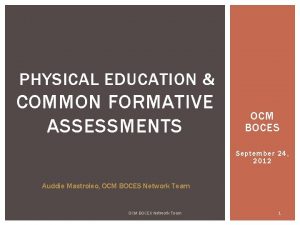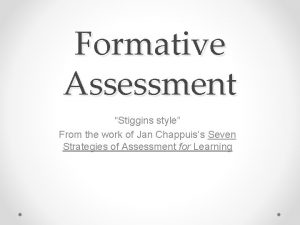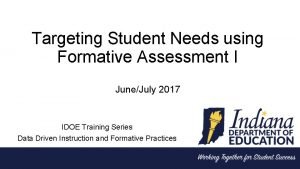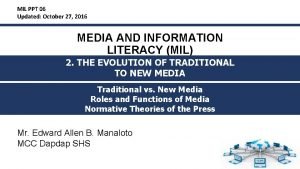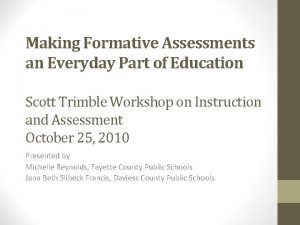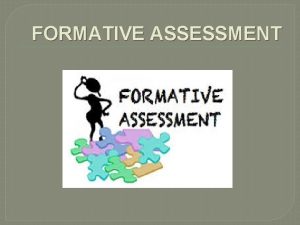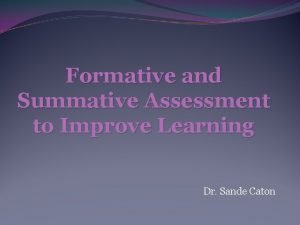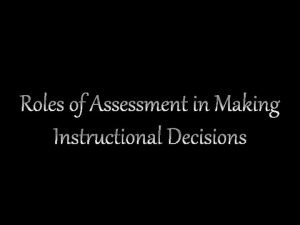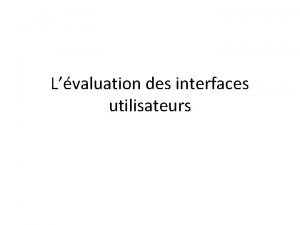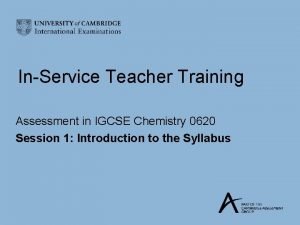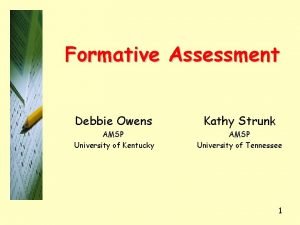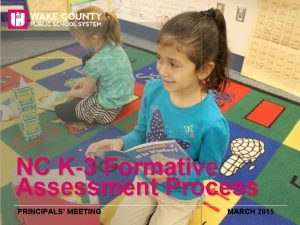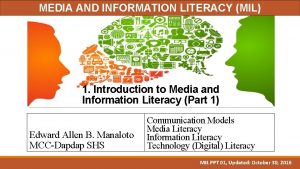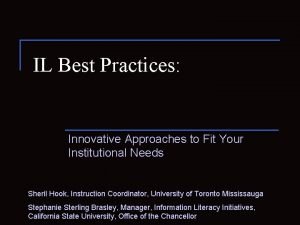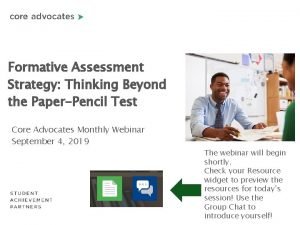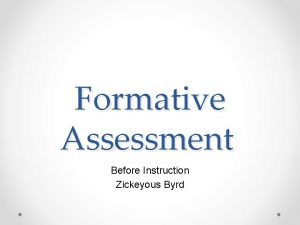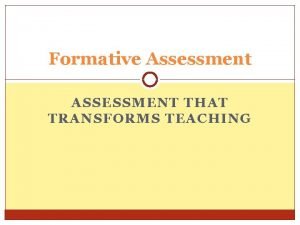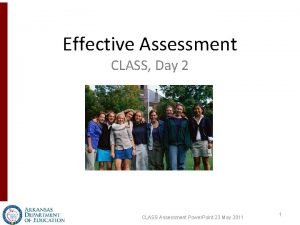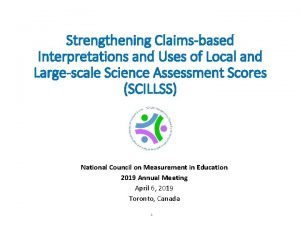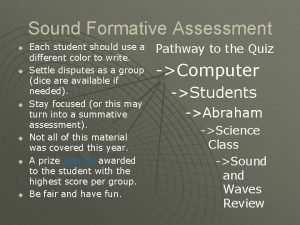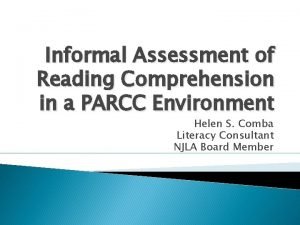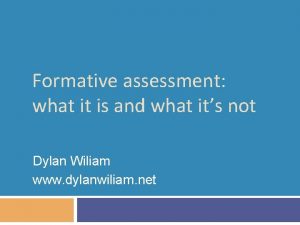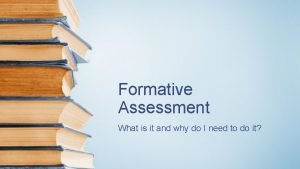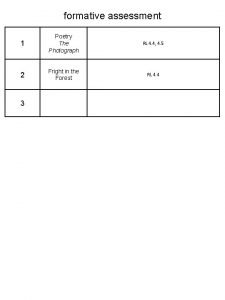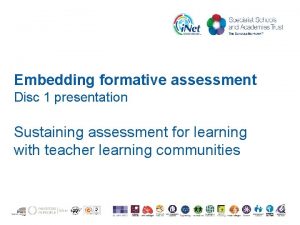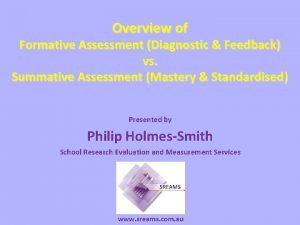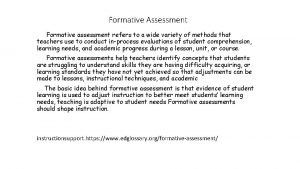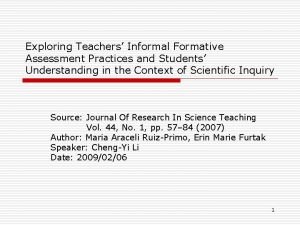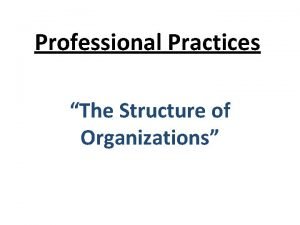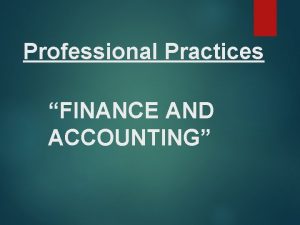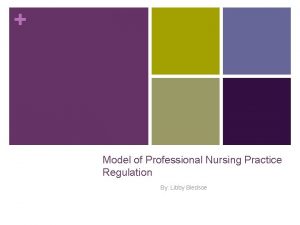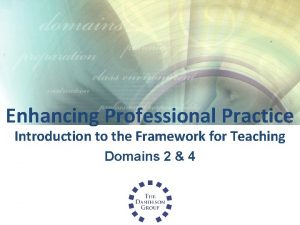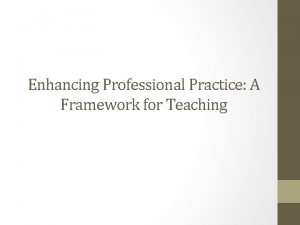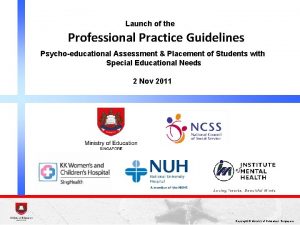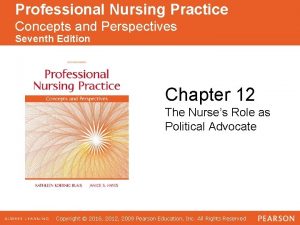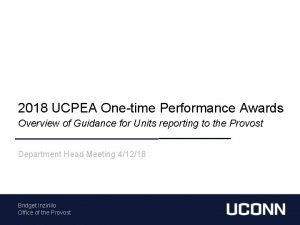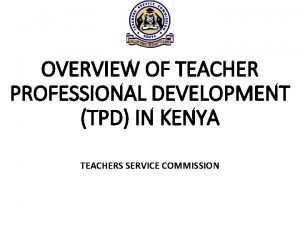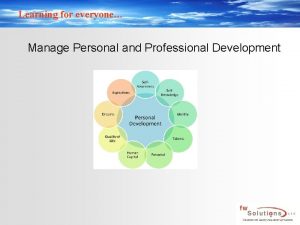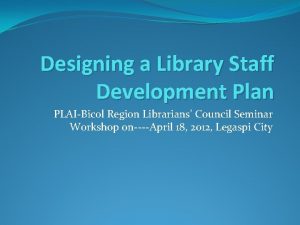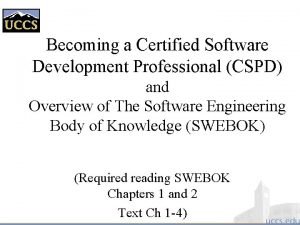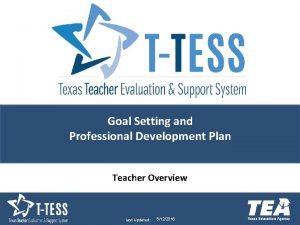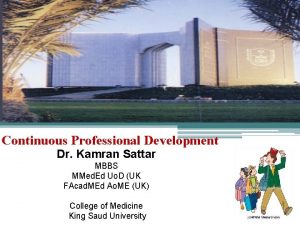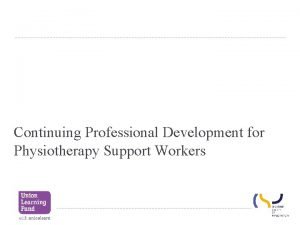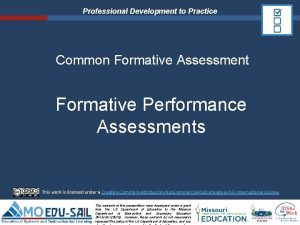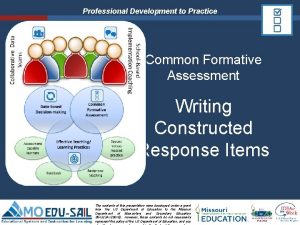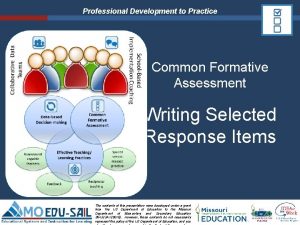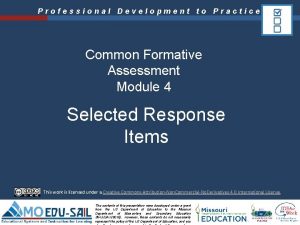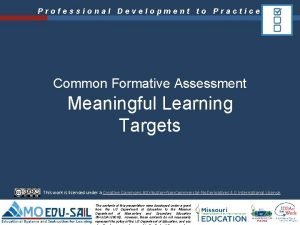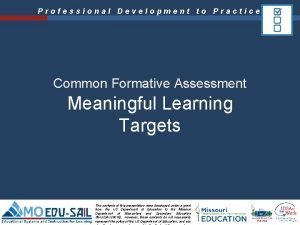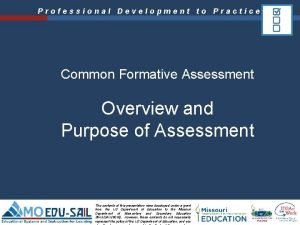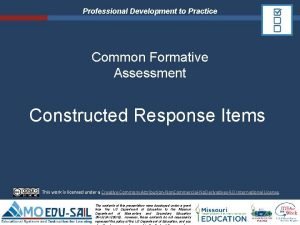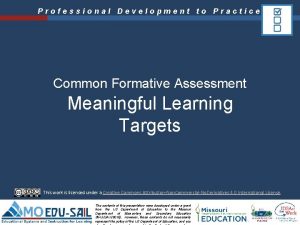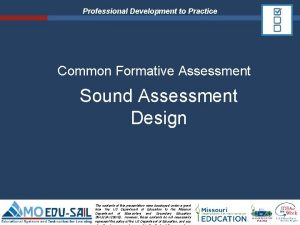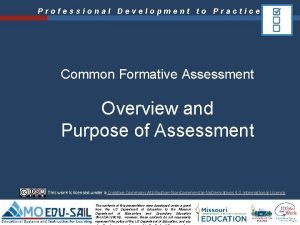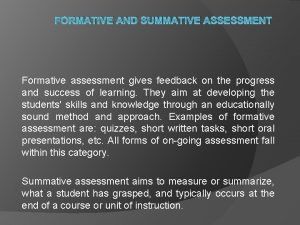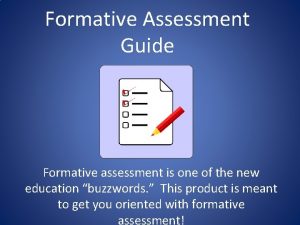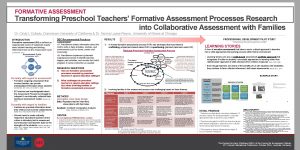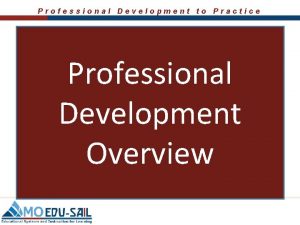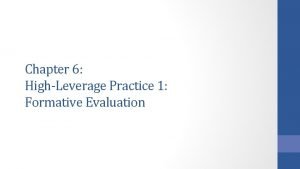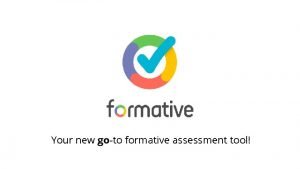Professional Development to Practice Common Formative Assessment Writing



















































































- Slides: 83

Professional Development to Practice Common Formative Assessment Writing and Using Performance Tasks The contents of this presentation were developed under a grant from the US Department of Education to the Missouri Department of Elementary and Secondary Education (#H 323 A 120018). However, these contents do not necessarily represent the policy of the US Department of Education, and you

Professional Development to Practice

Professional Development to Practice Common Formative Assessment (CFA) Overview and Purpose of CFA Writing and Using Performance Tasks Developing Meaningful Learning Targets Quality Assessment Design

Professional Development to Practice Personal Reflection q What is a performance task? q What is the purpose of a performance task? q How does a performance task fit into a curricular unit of study?

Professional Development to Practice Goals for Training As a result of this training you will learn… q. What part performance tasks play in state assessment, q. How performance tasks fit into curriculum, q. The characteristics of a good task and rubric, q. The process for developing a task and rubric, q. The process for evaluating the quality of a

Professional Development to Practice Discovery Learning q. Discover the characteristics of a performance task.

Professional Development to Practice Handout Packet

Professional Development to Practice

Professional Development to Practice

Professional Development to Practice

Professional Development to Practice

Professional Development to Practice

Professional Development to Practice

Professional Development to Practice Share Your Ideas What did you discover? What are the characteristics of a performance task?

Professional Development to Practice Purpose of Tasks The purpose of the task is to measure progress toward a learning target(s) by eliciting a demonstration or artifact so it can be assessed by the rubric or checklist.

Professional Development to Practice Characteristics of a PT A performance task…… q Consists of two parts----A task and scoring criteria q Has as its main purpose…. the measurement of performance towards mastery of a learning target (or targets) q Performance quality is recorded on a checklist or rubric q Has the capability of measuring multiple-learning targets q Measures the high-level cognitive processes (i. e. analysis, synthesis, evaluation, problem-solving, etc. )

Professional Development to Practice Characteristics of a PT A performance task… q Has a written prompt that cues the student to perform some type of task that requires… q. A demonstration q. A presentation or q. Product creation q Shows connections by measuring learning targets from different content areas or from different strands q Requires application of knowledge in a real-world context or setting q May be completed on one or more sittings or over time

Professional Development to Practice Characteristics of a PT A performance task… q. Allows for choices when practical q. Choice options must be equivalent q. Same target and same level of difficulty

Professional Development to Practice Non-Negotiable Qualities of a PT q 1. Produce evidence of the learning target q 2. Provide a realistic context q 3. Model what application of learning looks like in life beyond the classroom q 4. Point the way to success without doing the thinking for the student and give expectations upfront q 5. Not depend on unrelated skills for success q 6. Allow for the availability of necessary resources

Professional Development to Practice Performance Tasks in Education q. Used on large scale assessments q. Will be used in ELA and Math by Smarter Balanced Assessment Consortium (SBAC) q. Used by schools and districts as summative assessments q. Used by classroom teachers in a summative way to determine if students have mastered learning targets q. Used by teachers formatively to support learning.

Professional Development to Practice ELA Performance Tasks q. Usually involve reading or researching, synthesizing findings then communicating q. Usually measure learning targets from across strands q. Many times are divided into two parts q. Information gathering q. Using information to write or speak

Professional Development to Practice Math Performance Tasks q Almost always involve real life problems and multiple steps or parts q May be a series of constructed-response questions or one prompt that cues several steps q May require some type of presentation of a student’s mathematical findings (i. e. present your proposal, present your budget, etc. ) q May require the student to present mathematical evidence as support q May require use of technology or the completion of graphs, charts, etc. q Use stimulus material (i. e. charts, graphs, data sets, ad sheets, etc. ) q Require application of mathematical skills and allow for multiple-approaches for solving the problem q Some math performance tasks are more open-ended than others

Professional Development to Practice Two Types of Math PTs Real World Application Mathematical Problem Solving Process Those that involve multiple-steps and real Those that involve the four phases in the -world application to create a final mathematical problem-solving process in product and communicate the results. For order to arrive at an answer. example…. Given a mathematical problem to solve Student Prompt: You are a contractor that is open-ended and whose solution has been asked to construct a work shed process is not apparent, the student for the school district, according to follows the four-phases of the specifications and at or under budget. mathematical problem-solving process to You will create a plan according to specs, attempt to arrive at an answer. figure total cost using catalogs, create a written proposal, and present your ideas and justification in written format to the school board.

Professional Development to Practice Social Studies Tasks q. May ask students to do an investigation of a current societal problem or issue q. May ask students to research historical event, synthesize findings and write a paper, give a presentation or create a product q. Some deal with the violation of personal rights and freedoms. q. Some ask students to compare and contrast different historical events and

Professional Development to Practice Science Performance Tasks q May involve scientific inquiry about an environmental problem or a controversial issue related to a scientific discovery or scientific research q May involve some type of performance related to the scientific method or process q May ask students to design and conduct an experiment or product q May require observation and collection of data over time. q May be presented as a series of constructed response questions with one building upon the other or as one lengthy prompt

Professional Development to Practice Non-Core Performance Tasks q Use a real-world context to cue the creation of a product, presentation or demonstration q Show the connection of isolated discrete skills learned in class through the use of a real world scenario q May be a series of constructed-response questions or one lengthy prompt that cues several steps q May require presentation of evidence (i. e. present your findings, proposal, budget, etc. ) q May require use of technology or the completion of forms, a spreadsheet, etc. q Use stimulus material (i. e. charts, diagrams, graphs, menus, diagrams, ad sheets, etc. )

Professional Development to Practice Written tasks can and should be used in all content area classes or courses.

Early Primary ELA Professional Development to Practice

Professional Development to Practice This PT measures one process, basic understanding in three content areas, and two higher level reasoning skills. Can you guess what these might be?

Professional Development to Practice

Professional Development to Practice

Professional Development to Practice

Professional Development to Practice

Professional Development to Practice

Professional Development to Practice

Professional Development to Practice

Professional Development to Practice

Professional Development to Practice

Professional Development to Practice Sci ent ific Inq Inf uir orm y ati on al Ess ay ogy l o hn h c e f t searc o e Us nd re a

Professional Development to Practice d e c n a l a B r e t r a Sm t n e m s s e s s A A L E m u i t r o s n s k Co s a T e c n a m r o f Per

Professional Development to Practice Design of Performance Tasks Use 1 -2 Stimuli for Grade 3. Use up to 5 stimuli for high school. Emphasis on stimuli related to science, history, and social studies. • Components of a Performance Task Stimulus Readings Information Processing Research questions Video clips Audio clips Graphs, charts, other visuals Research topic/issue/ problem etc. Comprehension questions Simulated Internet search Product/Performance Essay, report, story, script Speech with/without graphics, other media Responses to embedded constructed response questions. etc.

Professional Development to Practice Parts of Performance Task • Part 1: Student reads research sources and responds to prompts (Claim 1 or 4) • Part 2: Student plans, writes, and revises his or her full essay (Claim 2) or plans and delivers a speech (Claim 3)

Professional Development to Practice Test Administration • Maximum Time Requirements for Performance Tasks – Grade 3– 8: • 105 minutes total Part 1: 35 min. Part 2: 70 min. – High School: • 120 minutes total Part 1: 35 -45 min. Part 2: 75 -85 min.

Professional Development to Practice Sample Performance Task

Professional Development to Practice Directions

Professional Development to Practice Part 1

Professional Development to Practice Part 2

Professional Development to Practice Scoring Information q How your essay will be scored: The people scoring your essay will be assigning scores for: – Statement of purpose/focus—how well you clearly state your claim on the topic, maintain your focus, and address the alternate and opposing claims – Organization—how well your ideas logically flow from the introduction to conclusion using effective transitions, and how well you stay on topic throughout the essay – Elaboration of evidence—how well you provide evidence from sources about your opinions and elaborate with specific information – Language and Vocabulary—how well you effectively express ideas using precise language that is appropriate for your audience and purpose – Conventions—how well you follow the rules of usage, punctuation, capitalization, and spelling

Professional Development to Practice Grade 6 Sample Performance Task

Professional Development to Practice d e c n a l a B r e t r a t m n S e m h s t s a e M s m As s u i k t s r a o s T n e Co rmanc o f r Pe

Professional Development to Practice DOK Level 4 Example Grade 8 During the task, the student assumes the role of an architect who is responsible for designing the best plan for a park with area and financial restraints. The student completes tasks in which he/she compares the costs of different bids, determines what facilities should be given priority in the park, and then develops a scale drawing of the best design for the park and an explanation of the choices made. This investigation is done in class using a calculator, an applet to construct the scale drawing, and a spreadsheet.

Professional Development to Practice Grade 3 Performance Task

Professional Development to Practice

Professional Development to Practice

Professional Development to Practice

Professional Development to Practice

Professional Development to Practice

Professional Development to Practice

Professional Development to Practice

Professional Development to Practice

Professional Development to Practice

Professional Development to Practice

Professional Development to Practice Paired Verbal Fluency Summarize what you have learned about performance tasks up to this point.

Professional Development to Practice Components in the Prompt 1 2 3 4 5 Include in the task a statement of the knowledge to be applied. Tell students what they are to accomplish. If materials are required to be used, include this information. The time or timeline given for completion should be included. If the task calls for a demonstration or performance, it should specify the conditions under which the demonstration or performance is to take place. 6 The task should include a reminder of the elements of quality you will use to assess it. You can either attach the rubric or place the criteria on the bottom of the prompt. (Example from Classroom Assessment for Student Learning by J. Chappuis, R. Stiggins, S. Chappuis, and J. Arter P 216

Professional Development to Practice Prompt Containing the Six Components “Using a stopwatch and a measuring tape, you are to use your knowledge of physics in motion to design an experiment to determine the % of vehicles that exceed the speed limit as they pass school. Then, you are to conduct an experiment. Last you are to write a report in which you explain your experimental design and share your results with classmates. You will have three days to design and conduct your experiment and two days to write your report. Your report is due in one week. You may work with a partner or alone to design and conduct the experiment but you must submit an independent report that you alone have written. Your report will be scored on: q Understanding of physics equations, q Experimental design, q Collection and explanation of results. (Rubrics are attached. ) (Example from Classroom Assessment for Student Learning by J. Chappuis, R. Stiggins, S. Chappuis, and J. Arter P 216)

Professional Development to Practice Making a Task Authentic q. To make a task authentic, set the prompt in a real world scenario. Use the RAFT strategy. Assign a role, audience, format and topic. q. How might you make the prompt in the last slide more authentic?

Professional Development to Practice Steps in Writing a Performance Task

Professional Development to Practice Step 1 (Handout Packet) Begin with a cluster of learning targets usually 3 -4 that will work well together for the creation of a PT. q It works best if the learning targets are across strands or content areas to allow for greater diversity in performance q Learning targets from reading, writing and research work well together. q Learning targets from math, FACs and economics work well together. q Learning targets from science and communication arts work well together. q Learning targets must be board to allow for in-depth thinking and higher-level cognitive processes.

Professional Development to Practice Step 2 Define what mastery looks like for each learning target. q. Tell what students would have to know, do and understand to prove mastery of the learning target. q. Do not be overly conscious on prerequisites. Those should have been mastered previously. q. Note: If you want to assess only piece of the learning target that is alright but you must assess the other piece at a later date or in another way. So if you want to use just a piece, highlight the piece you are using.

Professional Development to Practice Step 3 Based on the definition of mastery, create a prompt that forces the student to demonstrate understanding of the knowledge to perform the skills and processes. Ø Set the prompt in a real world context, give a real world purpose, name the audience and tell the product to be created.

Professional Development to Practice Step 4 Double check the prompt against the learning targets and definitions of mastery to ensure it cues all the necessary actions needed to gather enough of and the right kind of evidence to prove mastery of all learning targets. If you have not assessed everything you feel you need to, you have two choices… cut down on the things you want to measure or expand the prompt.

Professional Development to Practice Step 5 Use the definitions of mastery and write criteria that needs to be assessed to be included in the scoring guide. Then write the scoring guide. (See steps in writing a scoring guide for a PT in handout packet. )

Professional Development to Practice Create a PT Prompt q. You have a cluster of learning targets. q. Follow the first five steps (listed in the handout packet) to create a prompt for a task.

Professional Development to Practice Steps in Writing Scoring Guides for PTs In handout packet

Professional Development to Practice Write a Rubric for Your Task q. Use the steps in the handout packet to write a scoring guide for your prompt.

Professional Development to Practice Evaluating a Task for Quality q Handout Packet. q Use the evaluation to evaluate a task.

Professional Development to Practice Evaluate Your Task q. Use the evaluation sheet to evaluate your task and rubric.

Professional Development to Practice Choosing Exemplar s or Anchors q Handout Packet. q First page of activity with a group. q Second page working alone.

Professional Development to Practice Additional Handouts FYI q. Writing rubrics from SBAC. q. Additional Information about observations and demonstrations.

Professional Development to Practice Profile

Professional Development to Practice Implementation Fidelity

Professional Development to Practice Q and As q. Who wants to ask the first question?

Professional Development to Practice Reflection What is the most important thing you learned in this training session? Why do you feel it is most important? Share ideas with a partner.
 Common formative assessment examples
Common formative assessment examples Formative assessment in style
Formative assessment in style Formative assessment cycle
Formative assessment cycle Formative assessment process
Formative assessment process Mil ppt
Mil ppt Subject mil
Subject mil People media value
People media value Formative assessment kwl
Formative assessment kwl évaluation formative
évaluation formative Formative test
Formative test Facets of formative assessment
Facets of formative assessment Difference between formative and summative assessment
Difference between formative and summative assessment Formative assessment 3
Formative assessment 3 What is summative evaluation in hci
What is summative evaluation in hci Nature of formative assessment
Nature of formative assessment Round robin charts formative assessment
Round robin charts formative assessment Formative assessment
Formative assessment Ritual or expressive model of communication
Ritual or expressive model of communication Formative assessment is tasting the soup while cooking
Formative assessment is tasting the soup while cooking Formative assessment
Formative assessment Examples of formative assessment
Examples of formative assessment Examples of formative assessment
Examples of formative assessment Formative assessment
Formative assessment Summative and formative assessment
Summative and formative assessment What is the aera
What is the aera Examples of formative assessment
Examples of formative assessment Norm referenced test and criterion referenced test
Norm referenced test and criterion referenced test Formative assessment
Formative assessment Formative assessment
Formative assessment What is summative assessment
What is summative assessment Formative assessment
Formative assessment Formative assessment
Formative assessment Formative assessment معنى
Formative assessment معنى Formative assessment for poetry
Formative assessment for poetry Formative assessment
Formative assessment Formative assessment marks
Formative assessment marks Diagnostic feedback definition
Diagnostic feedback definition Weaknesses of formative assessment
Weaknesses of formative assessment Informal formative assessment
Informal formative assessment Dylan wiliam formative assessment
Dylan wiliam formative assessment Professional practice days
Professional practice days Structure of organization in professional practice
Structure of organization in professional practice Finance and accounting in professional practice
Finance and accounting in professional practice Health promotion in nursing practice 7th edition
Health promotion in nursing practice 7th edition Professional business practice
Professional business practice Model of professional nursing practice regulation
Model of professional nursing practice regulation Ongoing professional practice evaluation template
Ongoing professional practice evaluation template Enhancing professional practice
Enhancing professional practice Danielson 3c look fors
Danielson 3c look fors Tpess training
Tpess training Enhancing professional practice: a framework for teaching
Enhancing professional practice: a framework for teaching Moe professional practice guidelines
Moe professional practice guidelines Political astuteness in nursing
Political astuteness in nursing It is to conform to accepted professional practice
It is to conform to accepted professional practice Common factors of 36 and 48
Common factors of 36 and 48 Common anode and common cathode
Common anode and common cathode Factor tree of 56
Factor tree of 56 Highest common factors and lowest common multiples
Highest common factors and lowest common multiples Common factors of 20 and 24
Common factors of 20 and 24 Highest common factors and lowest common multiples
Highest common factors and lowest common multiples The implementation of r.a. 10912 started on
The implementation of r.a. 10912 started on Norms for professional development
Norms for professional development Ecetp.pdp.albany.edu.elearning
Ecetp.pdp.albany.edu.elearning Development plan for teachers
Development plan for teachers Compare sources of information on professional development
Compare sources of information on professional development Professional development norms
Professional development norms Ppst domain 7 explanation
Ppst domain 7 explanation Ppst domain 6 reflection
Ppst domain 6 reflection 4 stages of professional development
4 stages of professional development Ucpea
Ucpea Professional development pathway
Professional development pathway Tpd in kenya
Tpd in kenya Navy medicine professional development center
Navy medicine professional development center Manage personal and professional development
Manage personal and professional development Excelsior scholarship contract
Excelsior scholarship contract Librarian professional development plan
Librarian professional development plan Frontline professional development
Frontline professional development Quote about professional development for teachers
Quote about professional development for teachers Professional development
Professional development Initial professional development
Initial professional development Certified software development professional
Certified software development professional Teacher professional development plan template texas
Teacher professional development plan template texas Continuing professional development
Continuing professional development Continuing professional development
Continuing professional development
